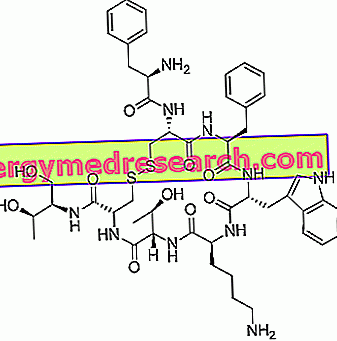Generality
Potentially pathogenic fungi are organisms capable of causing disease in humans or other living organisms.

Infections induced by potentially pathogenic fungi are known as mycoses. There are 5 types of mycoses: superficial mycoses, cutaneous mycoses, subcutaneous mycoses, systemic mycoses due to primary pathogens and systemic mycoses due to opportunistic pathogens.
Among the fungi with pathogenic properties, the well-known Candida albicans (which causes candidiasis or candidiasis), Aspergillus fumigatus (which causes aspergillosis), Cryptococcus neoformans (which causes cryptococcosis), Histoplasma capsulatum (which causes histoplasmosis), Pneumocystis carinii (which causes pneumocystosis) etc.
What are mushrooms?
Mushrooms intended as potentially pathogenic fungi are eukaryotic organisms, capable of causing disease in humans or other living organisms.
Mushrooms with pathogenic properties are divided into two main categories: yeasts (singular yeast ) and molds (singular mold ). Yeasts are micro-organisms, as they are single-celled, that is, composed of only one cell; molds, on the other hand, are organisms consisting of more than one cell, ie they are multicellular.
In fact, it should be pointed out immediately that the distinction between yeasts and molds is not always so clear. In fact, depending on the environmental conditions in which they live, some pathogenic fungi can behave like a generic yeast or a generic mold; mushrooms with such capacities are called diformic .
Among the potentially pathogenic fungi, there are saprophytic organisms (that is, that feed on dead organic matter) and parasitic organisms (that is, that live at the expense of other organisms).
HOW IS THE STUDY OF PATOGENIC MUSHROOMS FOR THE HUMAN BEING CALLED?
The branch of medicine that treats the study of pathogenic fungi is called medical mycology . Mycology is the term that indicates the discipline of biology that studies mushrooms in general.
WHAT IS THE NAME OF THE DISEASES CAUSED BY PATOGENIC MUSHROOMS?
Diseases caused by potentially pathogenic fungi are infectious diseases or infections.
In specialized parlance, infections with potentially pathogenic fungi are called mycoses .
Since there are so many types of pathogenic fungi, there are also numerous types of mycoses.
To simplify the study of the enormous variety of mycoses, doctors have decided to classify the infectious diseases in question based on the site of infection. According to the site of infection, mycoses are divided into 5 large groups: superficial mycoses, cutaneous mycoses, subcutaneous mycoses (or subcutaneous mycoses ), systemic mycoses due to primary pathogens and systemic mycoses due to opportunistic pathogens .
Biology
After numerous debates on the subject, the scientific community has decided that mushrooms represent a realm of its own, different then from the kingdom of plants, from the kingdom of animals, from the realm of bacteria, etc.

CELLULAR CHARACTERISTICS OF MUSHROOMS
Like the cells of each eukaryotic organism, the fungal cells contain an organized nucleus and enclosed within its own specialized compartment, have a DNA divided into chromosomes, have organelles and possess an articulated system of membranes inside the cytoplasm .
Mushrooms have some cellular peculiarities similar to those of animals, plants or bacteria. In other words, in some respects they are comparable to animals, while in other respects they are similar to plants or bacteria. Taken together, all these similarities mean that mushrooms are a type of organism in its own right, with animal, vegetable and bacterial characteristics.
To better understand:
- Much like animals, fungal cells possess mitochondria and not chloroplasts (typical of plants). Furthermore, they are heterotrophs . A heterotrophic organism is a living being incapable of synthesizing the organic substances necessary for life from inorganic substances, as plants do ( autotrophic organisms); lacking this potential, the only way to survive is to feed on the organic substances produced by other organisms.
- Similar to plants, fungal cells have a cell wall, around the cytoplasmic membrane, and the vacuole .
- Similar to bacteria, fungal cells are capable of synthesizing the amino acid L-lysine .
Clearly, if mushrooms possess mitochondria, like animals, they cannot be plants or bacteria; but they cannot even be animals, because their cells are wrapped in a cell wall, contain a vacuole and have the ability to synthesize the amino acid L-lysine (which are peculiarities of plants and bacteria).
Is the cell wall of fungi like that of plants?
From the structural point of view, the cell wall of fungi is different from that of plants. In fact, unlike the plant cell wall, it also contains a substance known as chitin .
REPRODUCTION OF PATOGENIC MUSHROOMS
Pathogenic fungi are characterized by three modes of reproduction: binary splitting, budding and sporogenesis .
Binary splitting and budding are typical of yeasts, while sporogenesis distinguishes the reproductive processes of molds.
WHAT ARE IFE?
Hearing the descriptions of the mushrooms or reading something about it, many readers will surely have encountered the term ifa (plural hypha ).
Briefly, the hyphae are the filamentous structures forming the so-called mycelium (ie the vegetative body of the fungi) and which distinguish the vegetative growth process, typical of fungi.
Unicellular or multicellular, hyphae contain a large number of organic molecules, including proteins, lipids, etc.
Among the pathogenic fungi, the only ones that do not exploit hyphae for vegetative growth are yeasts
Clinical aspects
Rarely, fungi with pathogenic abilities infect healthy people. In fact, they usually attack individuals who:
- Suffer from diabetes . The high concentration of glucose in the blood ( hyperglycemia ), typical of diabetes, favors the proliferation of some particular fungi that populate certain anatomical areas of the human body and that, under normal conditions (ie absence of diabetes), are completely harmless.
- They have undergone inadequate antibiotic therapies or for too long periods . Prolonged and / or inadequate intake of antibiotics destroys the intestinal bacterial flora. The latter has the task of controlling the proliferation of fungi with pathogenic capacities, present physiologically within the human intestine. The impairment of the bacterial flora makes it easier to spread potentially pathogenic fungi in the human being concerned.
- They have an ineffective immune system . The immune system is an organism's defensive barrier against threats from the external environment, such as viruses, bacteria, fungi etc., but also from the internal environment, such as cancer cells (the so-called "mad cells") ) or malfunctioning.
To affect the efficiency of the human immune system may be morbid conditions, such as AIDS (ie HIV infection) or taking certain drugs, such as corticosteroids, chemotherapeutic drugs or immunosuppressants.
Moreover, it is good to remember that a weak immune system is typically present in very young subjects (because it is not yet fully developed) and in very elderly subjects (because it undergoes a physiological decrease in efficacy).
Examples
This chapter describes the main potentially pathogenic fungi, subdividing them, to simplify the consultation by the reader, based on the site of infection.
SURFACE MYCOSIS
The superficial mycoses involve the most external layers of the skin, the hair and / or the cutaneous hairs. They have the particularity of not evoking any immune response.
The main pathogenic fungi that cause superficial mycoses are:
- Piedraia hortae . It is responsible for an infection known as black piedra . The black piedra is a disease of the scalp, which involves the formation of brown / black nodules on the hair shaft. Piedraia hortae infections are uncommon in the world, except in the tropical areas of Africa and South America. To promote infectious diseases from Piedraia hortae is the poor personal hygiene.
- The fungal pathogens known as Trichosporon . Trichosporon mushrooms, specifically Trichosporon asahii, Trichosporon beigeii, Trichosporon inkin and Trichosporon mucoides, are responsible for an infection known as piedra bianca . The white piedra involves the formation of numerous small roundish nodules, white in color, at the level of the hair and at the level of the hairs of the groin and armpits; sometimes it also affects the outer layers of the skin.
Trichosporon infections are particularly common in tropical and subtropical geographical areas. Poor personal hygiene favors its spread.
- Malassezia furfur . It is responsible for an infection called pityriasis versicolor, which causes hyperpigmentation or hypopigmentation of the skin.
Infectious diseases from Malassezia furfur mainly affect the anatomical area of the chest, neck, back and shoulders.
Heat, humidity, poor personal hygiene and increased sebaceous secretions are among the main factors favoring Malassezia furfur infections.
- Hortae werneckii (or Phaeoannellomyces ). It is a yeast. It is responsible for an infection known as tinea nigra . Tinea nigra is responsible for patches of varying size, irregular, often isolated, brown or black, on the palms of the hands and on the soles of the feet.
Infectious diseases from Hortae werneckii are particularly common in Central America, South America, Africa and Asia; they mainly affect children, adolescents and young adults.
CUTANEOUS MYCOSIS
Also known as ringworm, the cutaneous mycoses affect the keratinized layers of the epidermis, the hair, the hair and / or the nails (NB: keratinized means that they contain the keratin protein).
Unlike superficial mycoses, the cutaneous mycoses evoke an immune response and are responsible for a process of degradation of the epidermal layers containing keratin; this degradation process causes irritation, inflammation and, in some cases, even allergic reactions.
Called dermatophytes or dermatomycetes, the fungi responsible for the cutaneous mycoses are, mostly, filamentous fungi with the peculiarity of reproducing by spores.
In nature, there are three genera of dermatophytes: the genus Microsporum, the genus Trichophyton and the genus Epidermophyton .
- The genus Microsporum includes unicellular and multicellular fungi. The most known species of the genus Microsporum are: Microsporum audouinii, Microsporum canis and Microsporum gypseum .
All three species can cause episodes of ringworm on the scalp and the entire body, but, while Microsporum audouinii and Microsporum gypseum specifically affect humans, Microsporum canis affects dogs, cats and cattle with greater preference. Humans infected with Microsporum canis are generally people who live in close contact with infected animals.
- The genus Trichophyton includes unicellular and multicellular fungi. The most known species of the genus Trichophyton are: Trichophyton rubrum, Trichophyton mentagrophyes and Trichophyton verrucosum .
Trichophyton rubrum causes ringworm at the level of feet, hands, groin and / or nails. Readers are reminded that fungal infections of the nails are better known as onychomycosis .

Trichophyton mentagrophyes is the infectious agent responsible for the condition known as athlete's foot . Athlete's foot is a fungal infection that affects the areas between the toes and causes: red and itchy skin, skin thickening, skin peeling, blistering, appearance of skin cracks, smelly feet and thicker nails .
Finally, Trichophyton verrucosum is responsible for cutaneous mycoses especially among horses, donkeys, dogs and sheep; only in rare cases does it also infect the human being. In the latter, it affects the scalp, causing alopecia or baldness . Typically, humans who contract Trichophyton verrucosum infections live in close contact with the categories of animals mentioned above.
- The most important species of the genus Epidermophyton is Epidermophyton floccosum . The latter can cause ringworm in the feet, legs, arms and nails (onychomycosis).
Another classification of cutaneous mycoses
Experts classify the cutaneous mycoses also based on the natural habitat of the pathogenic fungus that causes them.
According to this classification, there are geophilic mycoses, zoophilic mycoses and mycosiantropophilics.
Geophilic mycoses
Geophilic mycoses are fungal infections caused by a pathogenic fungus that lives in the soil and is saprophytic of the soil. Contact with contaminated soil may cause it to spread.
An example of geophilic mycosis is that supported by Microsporum gypseum .
Zoophilic mycoses
The zoophilic mycoses are the fungal infections caused by a pathogenic fungus primary parasite of the animals, which can be transmitted to the human being for close contact.
Examples of zoophilic mycoses are the conditions induced by Microsporum canis or Trichophytonverrucosum .
Anthropophilic mycoses
Anthropophilic mycoses are fungal infections caused by a pathogenic fungus primary parasite of human beings, which rarely infects animals.
Examples of anthropophilic mycoses are the conditions supported by Trichophytonrubrum or Epidermophytonfloccosum .
SUBCUTANEOUS MYCOSIS
Evoking an immune response, subcutaneous (or subcutaneous) mycoses are fungal infections that can develop from the following: dermis, hypodermis (subcutaneous tissues), muscles, tendons or bone tissue. Subcutaneous mycoses are conditions whose treatment is not always simple.
The pathogenic fungi responsible for subcutaneous mycoses have the soil as a natural habitat and exert their infective power only when they enter the body through wounds or cuts on the skin. They are particularly common in tropical and subtropical areas of Africa, India and South America.
Divided according to the type of subcutaneous mycosis to which they give rise, the most known pathogenic fungi capable of triggering subcutaneous mycoses are:
- Fonsecaea compacta, Fonsecaea pedrosoi, Cladosporium carionii and Phialophora verrucosa → cause a type of subcutaneous mycosis known as chromoblastomycosis (or chromomicosis ). Chromoblastomycosis induces verrucoid, painful and itchy lesions, whose growth is slow and whose dimensions are variable. It involves subcutaneous tissues, but not bones, muscles and tendons.
- Madurella mycetomatis, Madurella grisea and Aspergillus → cause a type of subcutaneous mycosis known as mycetoma . Mycetoma is responsible for a granulomatous reaction, which involves the formation of tumor-like abscesses, accompanied by chronic inflammation, swelling and ulceration at the level of the infected anatomical region.
In addition to subcutaneous tissues, it can also involve bones and muscles.
- Sporothrix schenckii → causes a type of subcutaneous mycosis called sporotrichosis . In causing sporotrichosis, Sporothrix schenckii can enter the lymphatic system and disseminate, through the lymphatic vessels, into various organs of the human body, resulting in: pulmonary infections, bone infections, joint infections, endophthalmitis, meningitis and sinusitis.
SYSTEMIC MYCOSIS
Systemic mycoses are fungal infections affecting most or all of the organism. Like cutaneous mycoses and subcutaneous mycoses, they evoke an immune response.
The most known pathogenic fungi associated with systemic mycoses due to primary pathogens are:
- Blastomyces dermatitidis . It can exist both in the form of yeast and in the form of mold. It is responsible for an infection known as blastomycosis .
- Coccidioides immitis and Coccidioides posadasii . They can exist both as molds and as yeasts. They cause the so-called coccidioidomycosis (or valley fever )
- Histoplasma capsulatum . It can exist both as mold and as yeast. It is responsible for histoplasmosis .
- Paracoccidioides brasiliensis . It can exist both as mold and as yeast. It causes the so-called paracoccidioidomycosis (or South American blastomycosis ).
The main access route to the organism, used by these pathogenic fungi to infect humans, is the respiratory tract .
Turning then to the main pathogenic fungi associated with systemic mycoses due to opportunistic pathogens, these are:
- Candida albicans . It is a yeast; is responsible for the so-called candidiasis ;
- Cryptococcus neoformans . It is a yeast; cause cryptococcosis ;
- Some Aspergillus (eg: Aspergillus fumigatus, Aspergillus flavus etc). They are mold; cause aspergillosis ;
- Penicillium marneffei . It exists both in the form of mold and in the form of yeast; is responsible for penicilliosis ;
- Some Zygomycetes. They are mold; they cause an infection known as zygomycosis ;
- Pneumocystis carinii . It is a yeast; causes pneumocystosis .
Respiratory tract, digestive system and vascular system are the three ways in which the aforementioned pathogenic fungi can enter the human body.




